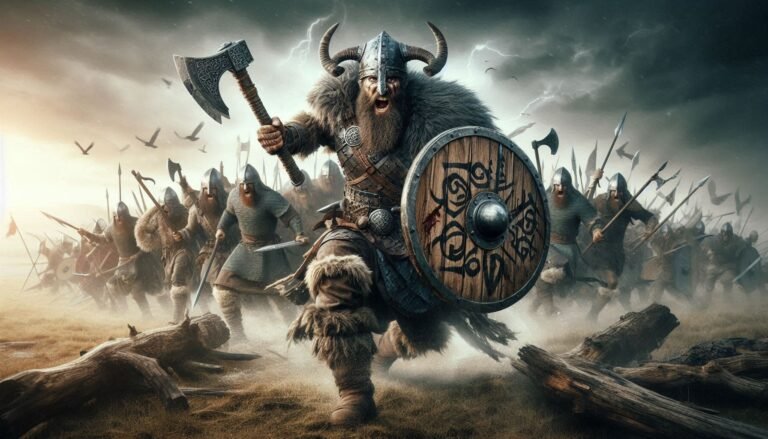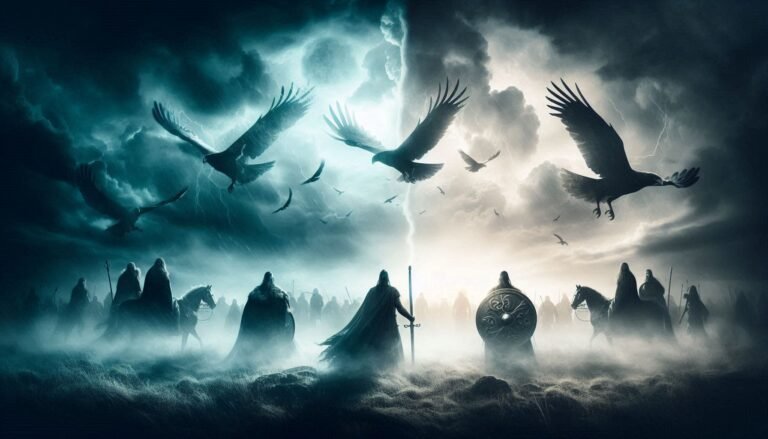For the Vikings, writing was not just a means of communication—it was a mystical and sacred practice deeply connected to their gods, myths, and way of life. The runic alphabet, known as the Futhark, was more than just a writing system; it was a gateway to divine wisdom, magic, and prophecy. In Norse mythology, runes were said to be gifts from Odin, the chief of the gods, who endured great suffering to bring their knowledge to humanity.
But what exactly were runes, and how were they used? How did they connect to Norse mythology, and what secrets did they hold? This article explores the origins, meanings, and mystical significance of runes in Viking society.
The Origin of Runes: Odin’s Sacrifice
Runes were deeply rooted in Norse mythology. According to legend, the runes were discovered by Odin, the Allfather, who was willing to suffer to obtain their knowledge.
The Myth of Odin and the Runes
In the Poetic Edda, Odin sought wisdom beyond that of gods and mortals. To achieve this, he:
- Hung himself from Yggdrasil, the World Tree, for nine days and nights.
- Pierced himself with his own spear, sacrificing himself to himself.
- Refused food and water, suffering in agony.
- After this ordeal, he gained the knowledge of runes, unlocking their power and secrets.
This myth symbolized the pain and sacrifice required to gain wisdom. It also showed that runes were not just a writing system but a sacred and magical form of knowledge.
The Runic Alphabet: The Futhark
The Viking runic alphabet, called Futhark, was named after its first six letters (F, U, Th, A, R, K). Over time, two main versions developed:
- Elder Futhark (150–800 CE):
- Contained 24 runes.
- Used by early Germanic tribes before the Viking Age.
- Younger Futhark (800–1100 CE):
- Contained 16 runes.
- Used by the Vikings for writing, magic, and marking objects.
Runes were carved into wood, bone, stone, and metal, as they were designed for inscriptions rather than manuscripts. Because of this, they have survived mainly on runestones, weapons, and jewelry.
Runes and Their Meanings
Each rune had both a phonetic value and a symbolic meaning. Some of the most important runes included:
| Rune | Name | Meaning |
|---|---|---|
| ᚠ (F) | Fehu | Wealth, prosperity |
| ᚢ (U) | Uruz | Strength, endurance |
| ᚦ (Th) | Thurisaz | Protection, conflict |
| ᚨ (A) | Ansuz | Wisdom, divine inspiration |
| ᚱ (R) | Raido | Travel, journey |
| ᛟ (O) | Othala | Heritage, homeland |
These meanings were not fixed and could change depending on the context in which the rune was used.
Runes as Magic and Divination
Runes were not just letters; they held mystical power. The Vikings believed that runes could influence fate and were used in various magical practices, including:
1. Runic Magic and Protection
- Runes were often carved onto weapons and shields to bring victory in battle.
- Viking warriors engraved runes on swords and axes, believing they could enhance strength and courage.
- Protective runes were inscribed on doorways and amulets to ward off evil spirits and curses.
2. Rune Casting and Divination
- Vikings used rune stones for fortune-telling and guidance.
- A seer or volva (female shaman) would cast rune stones onto the ground and interpret the patterns.
- Runes could provide warnings, insights, or predictions about the future.
3. Curses and Binding Spells
- Some runes were used for curses and hexes, binding enemies to misfortune.
- Runestones with warnings like “Whoever destroys this stone shall suffer a terrible fate” have been found across Scandinavia.
- The Vikings believed that misusing runes could bring disaster upon the user.
Runestones: Messages from the Past
The Vikings left behind thousands of runestones, carved with inscriptions about heroes, conquests, and memorials for the dead.
Famous Runestones
- The Rök Runestone (Sweden) – One of the longest runic inscriptions, telling stories of warriors and gods.
- The Jelling Stones (Denmark) – King Harald Bluetooth’s runestone, marking the Christianization of Denmark.
- The Kensington Runestone (USA?) – A controversial artifact claimed to be Viking, though its authenticity is debated.
These stones offer valuable insights into Viking culture, beliefs, and historical events.
Runes in Norse Mythology
Runes appear frequently in Norse myths and sagas, reinforcing their divine and mystical nature.
1. The Mead of Poetry
According to legend, Odin stole the Mead of Poetry, a magical drink that granted wisdom and poetic ability. Some believed runes were linked to this divine knowledge, allowing poets and warriors to gain inspiration and skill.
2. Sigurd and the Rune Magic
The hero Sigurd, famous for slaying the dragon Fafnir, learned the secret of runes from a Valkyrie named Brynhild. She taught him how to carve runes for healing, protection, and victory.
3. The Norns and the Web of Fate
The Norns, Norse fate-weavers, carved runes into Yggdrasil, shaping the destiny of gods and men. This highlights the belief that runes were woven into the fabric of existence.
The Enduring Legacy of Runes
Although the Viking Age ended in the 11th century, runes did not disappear. They continued to be used in Scandinavia for centuries, evolving into the Dalecarlian runes of Sweden.
Today, runes have found a new life in:
- Modern Paganism and Norse Spirituality – Many people practice rune divination and Viking-inspired magic.
- Pop Culture – Runes appear in books, video games, and films, such as The Lord of the Rings, God of War, and Assassin’s Creed: Valhalla.
- Tattoo Art and Symbolism – Many people tattoo runes as symbols of strength, wisdom, or heritage.
The Secret Language of the Vikings
Runes were more than just a way to write and communicate—they were a sacred link to the gods, fate, and magic. Whether carved onto stone, wood, or weapons, these symbols carried power, wisdom, and mystery.
Even today, the ancient Norse runes continue to fascinate and inspire, proving that their magic has never truly faded. Whether used for writing, divination, or personal meaning, the runes remain a timeless connection to the Viking world and its deeply spiritual past.



